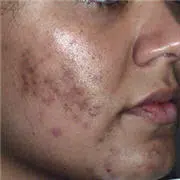You only have to look around you to see that acne is just about the most common skin problem in the world.

The precise trigger is not known and it can be a problem throughout life, but, regardless of a person’s age, acne is always a problem of blocked hair follicles and the response of the sebaceous glands attached to them which generate an oily material called sebum. Mix in some dead skin cells that end up “sticky” and block the skin pores, add in a dose of bacteria, and you’ve the ingredients of a breakout.
Physicians believe that these events, and acne itself, result from a number of related elements, including your hormones (which are responsible for boosting oil production) and genetics (the tendency to develop acne is frequently inherited from parents and also other relatives). Much less commonly, acne can occur as a response to particular medications and toxins, along with other physical factors that may well worsen the problem.
Pizza, French fries, and other greasy foods do not trigger acne or make it worse. But before you bring this erroneous idea to your mother’s attention, another one of her frequent sayings is absolutely correct, namely to: “Leave playing with your face.”
The appearance of teen acne (acne vulgaris is the technical term) is largely the end result of the body’s elevated production of hormones. The great news is that those unpleasant blemishes typically go away and are frequently gone for good by the time you reach your early twenties. However, the not-so-good news is that for some unfortunate people, acne vulgaris can persist into their late twenties or thirties or even beyond.